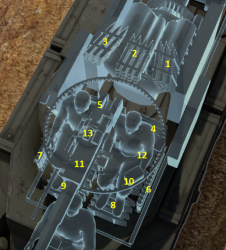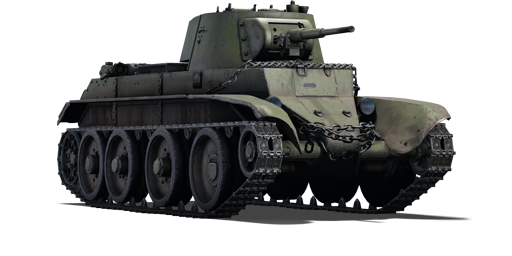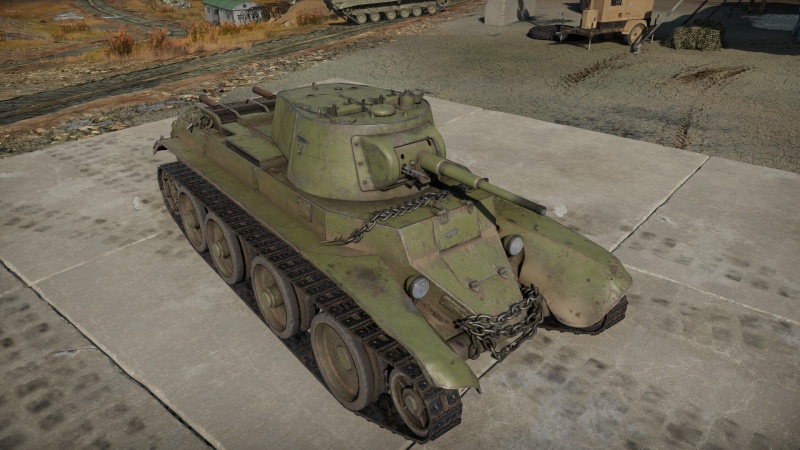Difference between revisions of "BT-7M"
(→Mobility) (Tag: Visual edit) |
(→Main armament) (Tag: Visual edit) |
||
| Line 52: | Line 52: | ||
{{Specs-Tank-Armaments}} | {{Specs-Tank-Armaments}} | ||
=== Main armament === | === Main armament === | ||
| − | {{Specs-Tank-Weapon|1}} | + | The BT-7M is equipped with the common 45mm 20-K cannon found on most early war Soviet tanks. The cannon is very beginner friendly, as it has a rather fast reload speed of ~3 seconds, allowing you to quickly fire more shots if the first shot failed to hit/one-shot. The velocity is adequate and the trajectory not too curved, meaning distant/moving targets are too worth a try. |
| + | |||
| + | The gun depression of -5° is worse than that of the BT-5 so now you will not be able to perform hull-down at certain spots, or you must expose more of your hull to do so. But since the BT-7M is not a large tank, it can still use this gun depression in some hilly terrains. The turret rotation can be a bit slow especially when you need to target tanks at diferent directions, but traversing the hull will generally help. | ||
| + | |||
| + | Note: you do not have a shoulder stabiliser like some other early war tanks, so if you suddenly encounter an enemy while driving at high speed it might be a good idea to just keep driving until you are in cover, instead of instinctively breaking to a stop and try to aim. Most vertically stabilised tanks like [[Pz.II (Disambiguation)|Pz.II]] will certainly complete the targeting process before you and shoot before you do which can be fatal. {{Specs-Tank-Weapon|1}} | ||
<!-- ''Give the reader information about the characteristics of the main gun. Assess its effectiveness in a battle based on the reloading speed, ballistics and the power of shells. Do not forget about the flexibility of the fire, that is how quickly the cannon can be aimed at the target, open fire on it and aim at another enemy. Add a link to the main article on the gun: <code><nowiki>{{main|Name of the weapon}}</nowiki></code>. Describe in general terms the ammunition available for the main gun. Give advice on how to use them and how to fill the ammunition storage.'' --> | <!-- ''Give the reader information about the characteristics of the main gun. Assess its effectiveness in a battle based on the reloading speed, ballistics and the power of shells. Do not forget about the flexibility of the fire, that is how quickly the cannon can be aimed at the target, open fire on it and aim at another enemy. Add a link to the main article on the gun: <code><nowiki>{{main|Name of the weapon}}</nowiki></code>. Describe in general terms the ammunition available for the main gun. Give advice on how to use them and how to fill the ammunition storage.'' --> | ||
{{main|20-K (45 mm)}} | {{main|20-K (45 mm)}} | ||
Revision as of 03:43, 17 December 2021
| This page is about the Soviet light tank BT-7M. For other versions, see BT-7 (Family). |
Contents
Description
The BT-7M is a rank I Soviet light tank with a battle rating of 2.0 (AB/RB/SB). It was introduced in Update "Ixwa Strike".
General info
Survivability and armour
The armour of the BT-7M features noteable improvements over the preceding BT-7. The frontal hull and the frontal half of the side hull are now 20mm, which makes it more effective at deflecting bullets/autocannon shells when angled and/or at a distance. Vehicles such as M16 MGMC and Flakpanzer 38 now might be somewhat less threatening due to your increased hull armour. The turret, however, keeps the same armour, which is 13-15mm all-round. This is inadequate to stop HMG bullets and any AP or even HE shells at any distance. It can only resist rifle caliber bullets from vehicles like Light AA Mk I. Overall, despite the thickened hull, the BT-7M is still protected in a light tank style and should not risk to take any hits.
The post-penetration survivability is just as poor as the other BT models. The only 3 crew are closely packed, with the gunner and commander right next to each other in the turret, and the driver directly in front of them. Any penetrating shots, regardless of explosive or solid, will have no issue taking out most/all of them. The weak armour also leads to the crew being vulnerable to over pressure damage. Vehicles with large caliber guns like the Sturmpanzer II and M4A3 (105) will easily destroy the BT-7M with a single HE shell. The only positive aspect is the large fuel tanks at the rear hull sides, outside the engine. These fuel tanks protect the engine by absorbing poorly aimed shots although they might be set aflame, thus keeping the BT-7M driveable for a few more seconds.
Armour type:
- Rolled homogeneous armour (hull, turret)
| Armour | Front (Slope angle) | Sides | Rear | Roof |
|---|---|---|---|---|
| Hull | 20 mm (18°) Upper plate 15 mm (61°) Middle plate 20 mm Lower plate |
20 mm Forward 15 mm + 4 mm Rearward |
10-13 mm | 10 mm Roof 4 mm Radiator grilles |
| Turret | 15 mm Turret front 15 mm Gun mantlet |
15 mm Forward 13 mm Rearward |
13 mm | 10 mm |
Notes:
- Suspension wheels, tracks and torsion bars are 15 mm thick.
- Belly armour is 6 mm thick.
Mobility
The BT-7M's mobility is just as classic as the other BT tanks. Although it is heavier than the earlier BT, at 14.2 tons, it is now driven by a powerful engine with a whopping 500hp, giving it a power/weight ratio of ~35. This allows it to pick up speed extremely fast and reach its top speed relatively easy. On hard surfaces like dirt/concrete road it can easily hit ~50 km/h, while on softer terrain it is usually ~40 km/h. This makes the BT-7M one of the fastest tracked vehicles in game, allowing it to get to any position quickly.
The reverse speed, at 11 km/h, is just enough to reverse you back into cover if you did not peek out far enough, if too far it will still be dangerously slow. The hull traverse is somewhat sluggish when the tank is stationary, often needing a short forward/backward jerk before turning. It does not lose a significant amount of speed when turning at high speed.| Game Mode | Max Speed (km/h) | Weight (tons) | Engine power (horsepower) | Power-to-weight ratio (hp/ton) | |||
|---|---|---|---|---|---|---|---|
| Forward | Reverse | Stock | Upgraded | Stock | Upgraded | ||
| Arcade | 69 | 12 | 14.7 | 775 | 954 | 52.72 | 64.9 |
| Realistic | 63 | 11 | 442 | 500 | 30.07 | 34.01 | |
Modifications and economy
Armaments
Main armament
The BT-7M is equipped with the common 45mm 20-K cannon found on most early war Soviet tanks. The cannon is very beginner friendly, as it has a rather fast reload speed of ~3 seconds, allowing you to quickly fire more shots if the first shot failed to hit/one-shot. The velocity is adequate and the trajectory not too curved, meaning distant/moving targets are too worth a try.
The gun depression of -5° is worse than that of the BT-5 so now you will not be able to perform hull-down at certain spots, or you must expose more of your hull to do so. But since the BT-7M is not a large tank, it can still use this gun depression in some hilly terrains. The turret rotation can be a bit slow especially when you need to target tanks at diferent directions, but traversing the hull will generally help.
Note: you do not have a shoulder stabiliser like some other early war tanks, so if you suddenly encounter an enemy while driving at high speed it might be a good idea to just keep driving until you are in cover, instead of instinctively breaking to a stop and try to aim. Most vertically stabilised tanks like Pz.II will certainly complete the targeting process before you and shoot before you do which can be fatal.| 45 mm 20-K | Turret rotation speed (°/s) | Reloading rate (seconds) | |||||||||||
|---|---|---|---|---|---|---|---|---|---|---|---|---|---|
| Mode | Capacity | Vertical | Horizontal | Stabilizer | Stock | Upgraded | Full | Expert | Aced | Stock | Full | Expert | Aced |
| Arcade | 188 | -5°/+20° | ±180° | N/A | 15.2 | 21.1 | 25.6 | 28.3 | 30.1 | 3.77 | 3.33 | 3.07 | 2.90 |
| Realistic | 9.5 | 11.2 | 13.6 | 15.0 | 16.0 | ||||||||
Ammunition
| Penetration statistics | |||||||
|---|---|---|---|---|---|---|---|
| Ammunition | Type of warhead |
Penetration @ 0° Angle of Attack (mm) | |||||
| 10 m | 100 m | 500 m | 1,000 m | 1,500 m | 2,000 m | ||
| BR-240 | APHEBC | 70 | 68 | 59 | 50 | 42 | 35 |
| BR-240SP | AP | 73 | 71 | 62 | 52 | 44 | 37 |
| Shell details | |||||||||
|---|---|---|---|---|---|---|---|---|---|
| Ammunition | Type of warhead |
Velocity (m/s) |
Projectile Mass (kg) |
Fuse delay (m) |
Fuse sensitivity (mm) |
Explosive Mass (TNT equivalent) (g) |
Ricochet | ||
| 0% | 50% | 100% | |||||||
| BR-240 | APHEBC | 760 | 1.43 | 1.2 | 9 | 29.26 | 48° | 63° | 71° |
| BR-240SP | AP | 757 | 1.43 | N/A | N/A | N/A | 47° | 60° | 65° |
Ammo racks

| Full ammo |
1st rack empty |
2nd rack empty |
3rd rack empty |
4th rack empty |
5th rack empty |
6th rack empty |
7th rack empty |
|---|---|---|---|---|---|---|---|
| 188 | 174 (+14) | 162 (+26) | 147 (+41) | 135 (+53) | 123 (+65) | 108 (+80) | 89 (+99) |
| 8th rack empty |
9th rack empty |
10th rack empty |
11th rack empty |
12th rack empty |
13th rack empty |
Visual discrepancy |
|
| 73 (+115) | 57 (+131) | 41 (+147) | 25 (+163) | 13 (+175) | 1 (+187) | No |
Notes:
- Racks disappear after you've fired all shells in the rack.
- Turret empty: 147 (+41) shells.
- Turret and side racks empty: 89 (+99) shells.
Machine guns
| 7.62 mm DT | ||||
|---|---|---|---|---|
| Mount | Capacity (Belt) | Fire rate | Vertical | Horizontal |
| Coaxial | 1,890 (63) | 600 | N/A | N/A |
Usage in battles
Describe the tactics of playing in the vehicle, the features of using vehicles in the team and advice on tactics. Refrain from creating a "guide" - do not impose a single point of view but instead give the reader food for thought. Describe the most dangerous enemies and give recommendations on fighting them. If necessary, note the specifics of the game in different modes (AB, RB, SB).
Pros and cons
Summarise and briefly evaluate the vehicle in terms of its characteristics and combat effectiveness. Mark its pros and cons in a bulleted list. Try not to use more than 6 points for each of the characteristics. Avoid using categorical definitions such as "bad", "good" and the like - use substitutions with softer forms such as "inadequate" and "effective".
Pros:
- Upgraded engine compared to the previous BT-7
- Fast-firing gun
- Exceptionally nimble, being able to turn its hull very quickly
Cons:
- Sits at a higher BR than the previous BT-7
- Armour remains thin, with heavy machine guns being able to penetrate and knock out crew members
- Only 3 crew members
- Oversteers at high speed, leading to it spinning out and/or drifting and loosing its speed
History
The BT-7M was an improved version of the Soviet BT-7 light tank developed before the Second World War. The main improvement was in terms of the powerplant, and at the time it was built no other tank in the world could reach the same speeds.[1]
Development
Development of a version of the BT-7 light tank began in the Soviet Union in 1938 with the construction of four prototypes at the Kharkov Locomotive Plant called the BT-8, which used a V12 diesel engine which was developed from the Hispano-Suiza 12Y aircraft engine. After the BT-8 was tested against the BT-7 it was determined to continue its development which resulted in the production version, designated BT-7M.[1][2]
Design
The BT-7M had the 500 horsepower V12 engine which was actually chosen partly due to greater fuel efficiency. The hull was reinforced with braces and some of the fuel storage was removed due to the higher fuel efficiency of the engine. The BT-7M’s engine also proved to be much safer in that it caught on fire much less often when hit by enemy fire. The BT-7M was proven to have a top speed of 62 km/h on tracks and 86 km/h with just wheels. Other than these changes, the BT-7M was fairly similar to the regular BT-7.[1][2]
Production and Service
The BT-7M entered production in 1939, replacing all earlier BT-7 variants on production lines. It was the last BT-7 variant produced with production lasting until 1941. Approximately 788 BT-7M tanks were built during that time period, being superseded on production lines by the T-34 medium tank. The BT-7M did end up seeing some combat during the Great Patriotic War.[1][2]
Media
- Skins
- Videos
See also
Links to the articles on the War Thunder Wiki that you think will be useful for the reader, for example:
- reference to the series of the vehicles;
- links to approximate analogues of other nations and research trees.
External links
Paste links to sources and external resources, such as:
- topic on the official game forum;
- other literature.
References
| USSR light tanks | |
|---|---|
| T-26 | T-26 · T-26 (1st Gv.T.Br.) · T-26-4 · T-26E |
| BT | BT-5 · RBT-5 · BT-7 · BT-7 TD · BT-7M · BT-7A (F-32) |
| T-50 | T-126 · T-50 |
| T-70 | T-70 · T-80 |
| PT-76 | PT-76B · PT-76-57 · Object 906 |
| BMP | BMP-1 · BMP-2 · BMP-2M · BMP-3 |
| BMD | BMD-4 |
| 2S25 | 2S25 · 2S25M |
| Wheeled | BA-11 · BTR-80A |
| Other | T-60 · Object 685 · 2S38 |
| China | ▂Type 62 |





